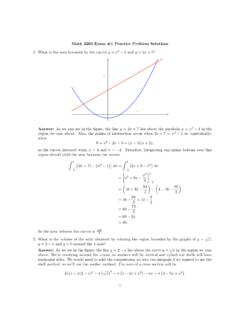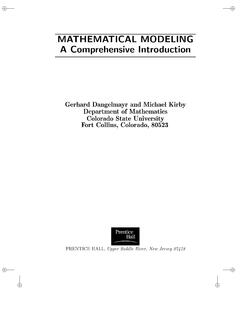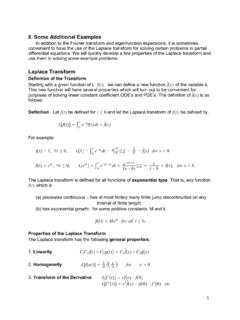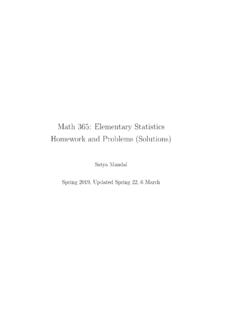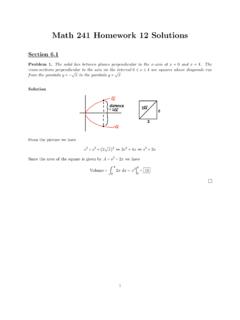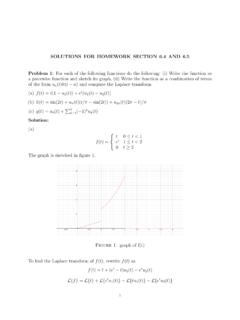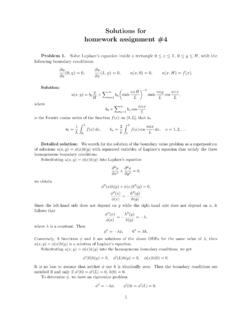Transcription of Jan 17 Homework Solutions Math 151, Winter 2012 …
1 Jan 17 Homework SolutionsMath 151, Winter 2012 chapter 2 Problems (pages 50-54) problem 2In an experiment, a die is rolled continually until a 6 appears, at which point the experi-ment stops. What is the sample space of this experiment? LetEndenote the event thatnrolls are necessary to complete the experiment. What points of the sample space arecontained inEn? What is( n=1En)c?The sample space consists of the following sequences of die rolls. If the sequence hasfinite length, then its last entry must equal six and no other entry can be six. If thesequence is infinite, then no entry can equal all sequences in the sample space of that n=1 Enis the event that the experiment terminates. Therefore, ( n=1En)cis the event that the experiment never terminates, ( n=1En)cis the set of sequencesin the sample space that have infinite 5A system is composed of 5 components, each of which is either working or failed.
2 Consideran experiment that consists of observing the status of each component, and let the outcomeof the experiment be given by the vector(x1, x2, x3, x4, x5), wherexiis equal to1if thecomponentiis working and is equal to0if the componentiis failed.(a)How many outcomes are in the sample space of this experiment?Since there are 5 components, each individually a 1 or 0, there are 25= 32 outcomesin the sample space.(b)Suppose that the system will work if components 1 and 2 are both working, or ifcomponents 3 and 4 are both working, or if components 1, 3, and 5 are all the event that the system will work. Specify all the outcomes of vectors (1,1, x3, x4, x5),x3, x4, x5either 0 or 1, (8 outcomes), (x1, x2,1,1, x5),x1, x2, x5either 0 or 1, (6 additional outcomes), and (1,0,1,0,1).
3 So there are 15outcomes inW.(c)LetAbe the event that components 4 and 5 are both failed. How many outcomesare contained in the eventA?Aconsist of vectors (x1, x2, x3,0,0) wherex1, x2, x3are each individually a 1 or 0,so there are 23= 8 outcomes inA.(d)Write out all the outcomes in the system works with components 4 and 5 failing only for vectors of the form(1,1, x3,0,0), wherex3is either 1 or 0 (2 outcomes). So the outcomes in the eventAWare (1,1,1,0,0) and (1,1,0,0,0).1 problem 8 Suppose thatAandBare mutually exclusive events for whichP(A) =.3andP(B) =. is the probability that(a)eitherAorBoccurs?SinceAandBare mutually exclusive,P(A B) =P(A) +P(B) =.3 +.5 =.8.(b)Aoccurs butBdoes not?SinceAandBare mutually exclusive,P(ABc) =P(A) =.3.(c)bothAandBoccur?SinceAandBare mutually exclusive,AandBcannot both occur, soP(AB) = 12An elementary school is offering 3 language classes: one in Spanish, one in French, andone in German.
4 These classes are open to any of the 100 students in the school. Thereare 28 students in the Spanish class, 26 in the French class, and 16 in the German are 12 students that are in both Spanish and French, 4 that are in both Spanish andGerman, and 6 that are in both French and German. In addition, there are 2 studentstaking all three classes.(a)If a student is chosen randomly, what is the probability that he or she is not in anyof the language classes?LetS,F, andGdenote the events of taking Spanish, French, and German, respec-tively. By the inclusion-exclusion identity, Proposition , we haveP(S F G) =P(S) +P(F) +P(G) P(SF) P(SG) P(F G) +P(SF G)=28100+26100+16100 12100 4100 6100+2100= the probability of not taking any of the classes isP((S F G)c) = 1 P(S F G) = 1 50100=50100.
5 (b)If a student is chosen randomly, what is the probability that he or she is takingexactly one language class?We present two different Solutions to this solution:Since there are 2 students taking all 3 classes, this means that thereare 12 2 = 10 students in Spanish and French but not German, 4 2 = 2 students in both Spanish and German but not French, and 6 2 = 4 students in both French and German but not we have 10 + 2 + 4 = 16 students taking exactly two language classes, and 2students taking exactly 3 language classes. We essentially computed in part (a) thatthere are 50 students taking at least one language class. So the number of studentstaking exactly one language class is 50 16 2 = 32. Hence the probability thata random student is taking exactly one language class solution:In the sum#S+ #F+ #G 2#SF 2#SG 2#F G+ 3#SF G,students taking only one language class are counted once, students taking twolanguage classes are counted 1 2 2 = 0 times, and students taking all threelanguage classes are counted 1 3 2 3 + 3 = 0 times.
6 Thus the probability oftaking exactly one language class isP(S) +P(F) +P(G) 2P(SF) 2P(SG) 2P(F G) + 3P(SF G)=28100+26100+16100 2 12100 2 4100 2 6100+ 3 2100=32100.(c)If 2 students are chosen randomly, what is the probability that at least 1 is taking alanguage class?We essentially computed in part (a) that there are 50 students taking at least onelanguage class. LetEi,i= 1,2, denote the event that thei-th student is taking alanguage class. By inclusion-exclusion, Proposition , we haveP(E1 E2) =P(E1) +P(E2) P(E1E2) =50100+50100 50 49100 99= 15If it is assumed that all(525)poker hands are equally likely, what is the probability of beingdealt(a)a flush? (A hand is said to be a flush if all 5 cards are of the same suit.)There are 4 choices for the suit and(135)choices for the cards in that suit.
7 Hencethe number of different flush hands is 4 (135), and the probability of a flush is4 (135)(525)=.001981.(b)one pair? (This occurs when the cards have denominationsa, a, b, c, dwherea, b, canddare all distinct.)There are 13 choices for the value ofa,(42)choices for the suits ofa,(123)choicesfor the values ofb, c,andd, 4 choices for the suit ofb, 4 choices for the suit ofc,and 4 choices for the suit ofd. Hence the probability of a one pair is13 (42) (123) 4 4 4(525)=. (c)two pairs? (This occurs when the cards have denominationsa, a, b, b, cwherea, b,andcare all distinct.)There are(132)choices for the values ofaandb,(42)choices for the suits ofa,(42)choices for the suits ofb, and 44 choices forcfrom the remaining cards. Thus theprobability of a two pair is(132) (42) (42) 44(525)=.
8 047539.(d)three of a kind? (This occurs when the cards have denominationsa, a, a, b, cwherea, b,andcare all distinct.)There are 13 choices for the value ofa,(43)choices for the suits ofa,(122)choicesfor the values ofbandc, 4 choices for the suit ofb, and 4 choices for the suit the probability of a three of a kind is13 (43) (122) 4 4(525)=.021128.(e)four of a kind? (This occurs when the cards have denominationsa, a, a, a, b.)There are 13 choices for the value ofa,(44)choices for the suits ofa, and 48 choicesforbfrom the remaining cards. Thus the probability of a four of a kind is13 (44) 48(525)=. 18 Two cards are randomly selected from an ordinary playing deck. What is the probabilitythat they form a blackjack? That is, what is the probability that one of the cards is anace and the other one is either a ten, a jack, a queen, or a king?
9 There are 4 possible aces and 4 4 = 16 tens, jacks, queens, and kings, so there are4 16 = 64 ways to select black jack. There are(522)ways to choose two cards. Thereforethe probability of black jack is64(522)=. 30 The chess clubs of two schools consist of, respectively, 8 and 9 players. Four membersfrom each club are randomly chosen to participate in a contest between two schools. Thechosen players from one team are then randomly paired with those from the other team,and each pairing plays a game of chess. Suppose that Rebecca and her sister Elise are onthe chess clubs at different schools. What is the probability that4(a)Rebecca and Elise will be paired?The probability that Rebecca will be chosen to represent her school is48. Theprobability that Elise will be chosen to represent her school is49.
10 Assuming thatboth Rebecca and Elise are chosen, the probability that they will be paired , the probability that Rebecca and Elise will be paired is48 49 14=118.(b)Rebecca and Elise will be chosen to represent their schools but will not play eachother?The probability that Rebecca will be chosen to represent her school is48. Theprobability that Elise will be chosen to represent her school is49. Assuming thatboth Rebecca and Elise are chosen, the probability that they will not be paired is34. Therefore, the probability that Rebecca and Elise will be chosen to representtheir schools but will not play each other is48 49 34=16.(c)either Rebecca or Elise will be chosen to represent her school?LetRbe the event that Rebecca is chosen to represent her school and letEbe theevent that Elise is chosen to represent her school.

